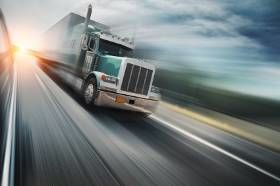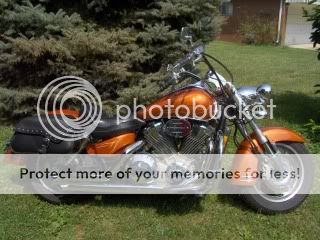Trying To Figure Out Double Clutching
Topic 1564 | Page 1

Welcome to the start of a new adventure. I just got my license this morning. So, all I can
tell is the state (insert yours here) gives us (drivers) a bit more strict test to make sure
we can handle the rig & all the extra stress while being tested. That's the why as far as I can
tell. Real world truth is you will float (gears) most of the time. An instructor at my school
at one time was a state examiner. She said they (not a hard rule just general) just needed to
see that we (drivers) know how to double clutch up & down a few gears. Then if we floated a few
they generally would not point us because they already seen you do it right. Also, a big scare
(to me any way) was don't let the rig travel more than the length of the rig out of gear.
Truth is you can't shift that fast at say 50 M.P.H. Take your time be smooth. Tell a joke.
Be friendly, be confident (not arrogant) & explain what or why you are doing things while you
drive. So, that they don't think you are scared. When you are just going slow because the red
light ahead you believe will change soon. You will be taught how to double clutch for the test
it's not a big deal if you slow down & take your time. Don't overwhelm yourself with needless
stress. We are often our own worst enemy. Good times & be safe.
BUG
P & D:
Pickup & Delivery
Local drivers that stay around their area, usually within 100 mile radius of a terminal, picking up and delivering loads.
LTL (Less Than Truckload) carriers for instance will have Linehaul drivers and P&D drivers. The P&D drivers will deliver loads locally from the terminal and pick up loads returning to the terminal. Linehaul drivers will then run truckloads from terminal to terminal.
Double Clutch:
To engage and then disengage the clutch twice for every gear change.
When double clutching you will push in the clutch, take the gearshift out of gear, release the clutch, press the clutch in again, shift the gearshift into the next gear, then release the clutch.
This is done on standard transmissions which do not have synchronizers in them, like those found in almost all Class A trucks.
Jason, Welcome to the forum!
Double clutching is one of those things they teach in school that you will hardly ever need again. It's kind of a throw-back to days gone by. With today's modern transmissions there is usually no need to double clutch , in fact there is little need to use the clutch at all. But, it is one of the things that is still looked at on the state examiners list of criteria that you need to know how to do. I know it sounds crazy, but it's typical of government to not really be on the ball when it comes to how things actually work in the real world. So, just to satisfy, the bureaucrats you're gonna have to be able to double clutch.
Here's a tip you can try. When double clutching in a big rig you shouldn't push the clutch all the way in. Everything in a big rig transmission is working off of the inertia and RPMs of the transmissions moving parts. When you engage the clutch pedal all the way you are engaging the clutch brake which slows or stops all that needed motion in the moving parts. All you want to accomplish is disengaging the clutch plate which will keep everything else spinning and make it easier for you to get in and out of the gears. The only time you need to push the clutch pedal all the way in is when you are at a complete stop and you want to get it in gear to start rolling. Every truck is a little bit different from each other, but for the most part you probably only need to engage the pedal about two inches to disengage the clutch plate. Try that and see if it doesn't help.
The other thing that I see people having trouble with when double clutching is just getting the rhythm of it down. For some people it is just an awkward thing. If this is giving you trouble you can practice in the privacy of your own room sitting on the couch. Just pretend that you are shifting the gears with your hand and use your leg to push in an imaginary clutch in and out as you go through the gears. Some people may think this sounds silly, but it helps some people to do this. When I was in school there was a young man in our class who just couldn't get it. The instructor basically gave up on him real quickly. I talked to him one day after class and took him to the Dollar Store and got him to buy a toilet plunger! I told him to go to his hotel room that night and pretend that was his shifter and sit down in a chair and practice going through the motions of double clutching while using that toilet plunger to go through the gear pattern. (He was also having trouble understanding the gear pattern on a ten speed) The next day when it was his turn to drive, he did much better on his shifting, and the teacher expressed his dismay by asking him "what has gotten into you, it's like a whole different person is sitting there today?" He just turned his head back at me and grinned. We have kept this little secret between ourselves until now when I shared it with you.
Anyways, I hope some of my ramblings will help you a little bit. Keep it up, it just takes some practice. Oh, and don't worry about those driving tests too much. Those examiners have seen it all, they don't expect you to be an expert when you come in there to test out. They just want to see that you are confident in your abilities of operating a big truck and that you are safe. They realize that you still have a long ways to go before you are a true professional, but as long as you demonstrate the basic understanding of how things are supposed to go you will become a new holder of a CDL. 
CDL:
Commercial Driver's License (CDL)
A CDL is required to drive any of the following vehicles:
- Any combination of vehicles with a gross combined weight rating (GCWR) of 26,001 or more pounds, providing the gross vehicle weight rating (GVWR) of the vehicle being towed is in excess of 10,000 pounds.
- Any single vehicle with a GVWR of 26,001 or more pounds, or any such vehicle towing another not in excess of 10,000 pounds.
- Any vehicle, regardless of size, designed to transport 16 or more persons, including the driver.
- Any vehicle required by federal regulations to be placarded while transporting hazardous materials.
Double Clutch:
To engage and then disengage the clutch twice for every gear change.
When double clutching you will push in the clutch, take the gearshift out of gear, release the clutch, press the clutch in again, shift the gearshift into the next gear, then release the clutch.
This is done on standard transmissions which do not have synchronizers in them, like those found in almost all Class A trucks.
Double Clutching:
To engage and then disengage the clutch twice for every gear change.
When double clutching you will push in the clutch, take the gearshift out of gear, release the clutch, press the clutch in again, shift the gearshift into the next gear, then release the clutch.
This is done on standard transmissions which do not have synchronizers in them, like those found in almost all Class A trucks.
HOS:
Hours Of Service
HOS refers to the logbook hours of service regulations.
. Also, a big scare (to me any way) was don't let the rig travel more than the length of the rig out of gear.
Truth is you can't shift that fast at say 50 M.P.H.
I believe they are talking about when bringing the truck to a stop, not so much about shifting on the highway. From what I've read that's one of the things they are looking for when downshifting before stoping, they don't want you pushing in the clutch for the stop and coasting for more than the length of the truck. Hope that makes sense.
Someone please correct me if I'm wrong.
New Reply:
New! Check out our help videos for a better understanding of our forum features

















Preview:








 TT On Facebook
TT On Facebook
in in class right now getting my cdl why do they want us to double cluth in the real world when i start driving will i have to double clutch also having a problem controlling the clutch whats a good practice to get good at it i want to pass all my test the first time
CDL:
Commercial Driver's License (CDL)
A CDL is required to drive any of the following vehicles:
Double Clutch:
To engage and then disengage the clutch twice for every gear change.
When double clutching you will push in the clutch, take the gearshift out of gear, release the clutch, press the clutch in again, shift the gearshift into the next gear, then release the clutch.
This is done on standard transmissions which do not have synchronizers in them, like those found in almost all Class A trucks.